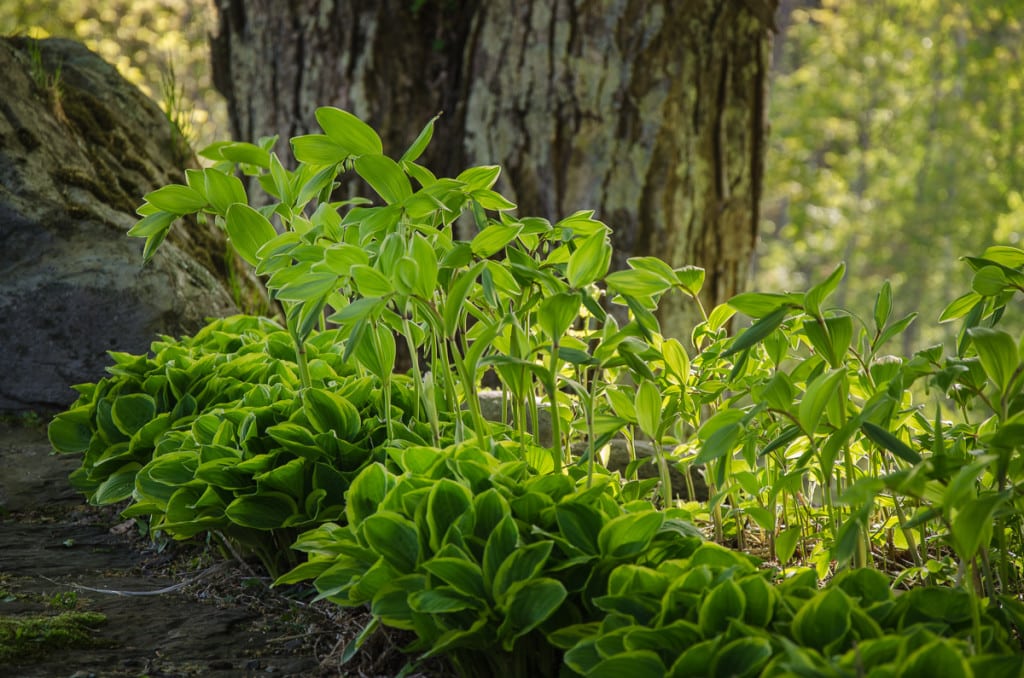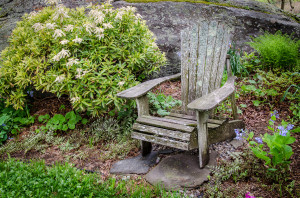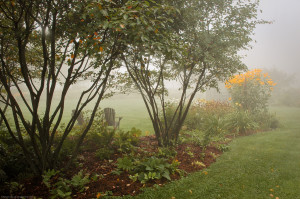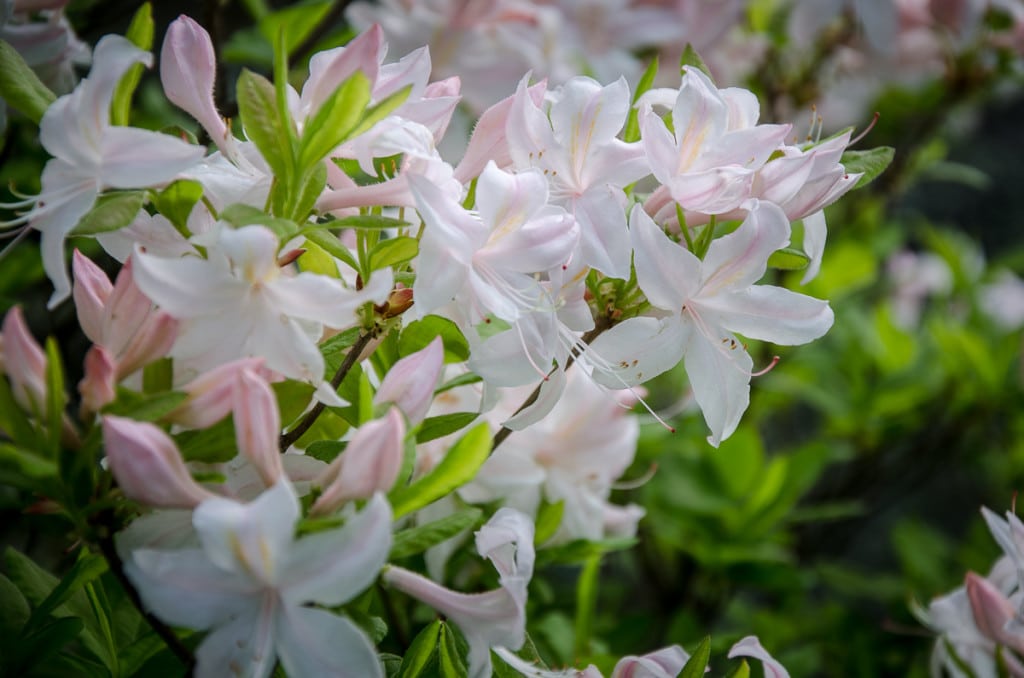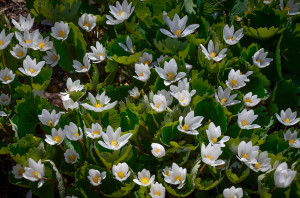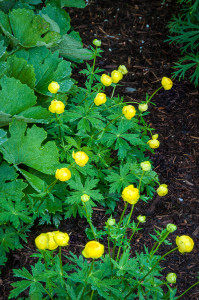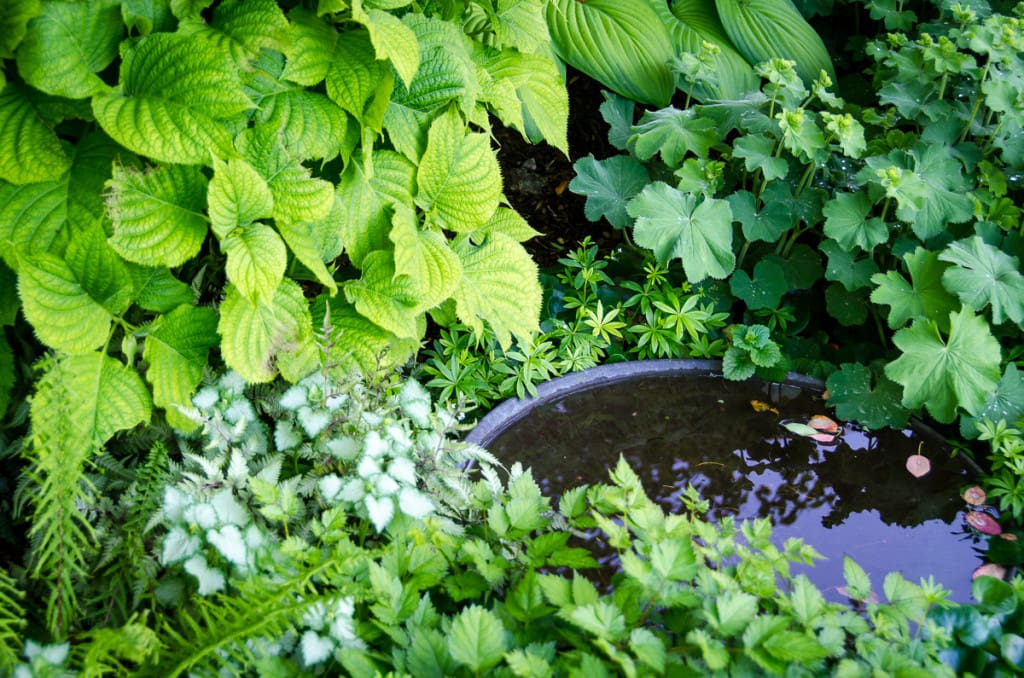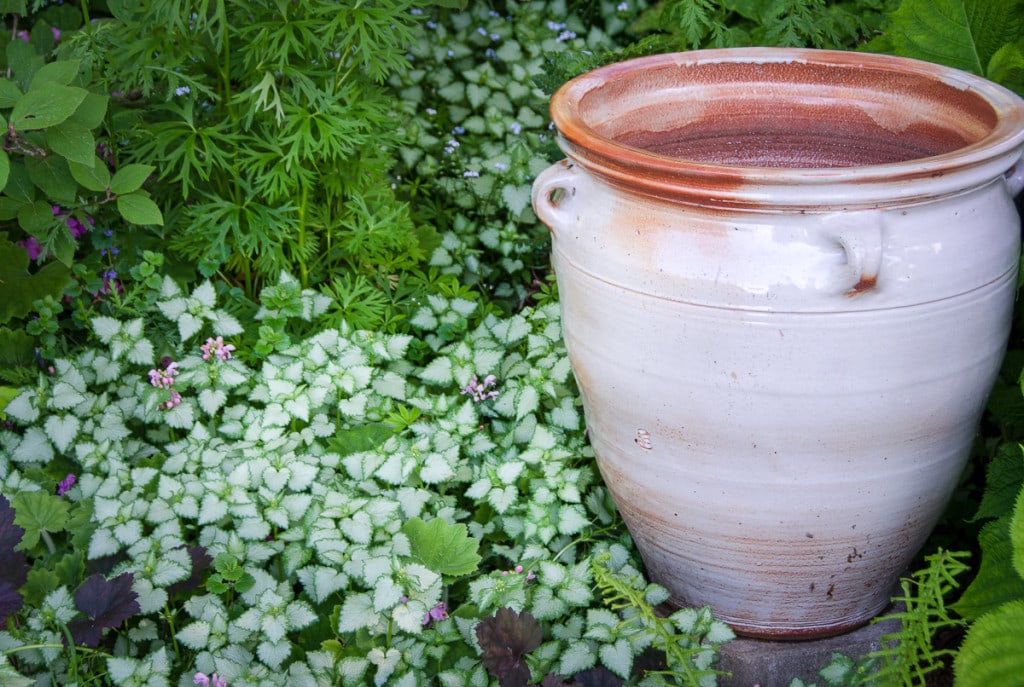Shady spaces
It’s a common lament: ‘My garden is too shady and boring. All I can grow are hostas‘!
I beg to differ. I delight in shady garden spaces—cool and tranquil places for people, that are also home for lots of interesting plants, hostas and many others.
Dick and I often retreat with our mid-morning ‘elevenses‘ to a favorite garden bench under the trees. Here we are in a private outdoor room, with its leafy ceiling and shrubby furnishing, a richly patterned carpet on the floor and a view to the sunny border beyond.
While shady corners may not have the color and sizzle of sun-drenched perennial beds, it is surely the contrast between these complementary spaces that creates a balanced whole. Think of it as the ‘yin and yang’ of the garden. And, to be complete, all gardens need some of each.
Since most of us are familiar with concept of an exuberant sunny border, let’s take a look at the potential for creating counterbalancing shady spots within the garden. I will show you several such spaces in my garden: their structure, the seasonal dynamics, and what makes them special in their own right.
Structure
To have garden shade you need a modicum of structural elements, especially trees and shrub, but also non-living elements such as the north wall of the house, or possibly a pergola or gazebo. And since they are large, these structural elements will dominate the overall design of a shade garden, so consider them carefully.
Majestic trees
Trees are a dominant presence in our gardens, and it behooves us to make the most of them. With a little thoughtful pruning, you can transform a trees into a living sculpture:
Begin by ‘pruning it up‘. Remove any low-hanging branches so that you can walk around unimpeded. This has the added advantage of letting additional light reach the plants below. Make your thinning cuts right back at the main trunk or, in the case of multi-stemmed trees and shrubs, right to the base.
Now take out any branches that clutter the tree’s interior. Your goal is to create a good scaffold of well spaced branches that all have room to develop fully.
As an example of this, about twelve years ago I planted a trio of Shadblow Serviceberries, Amelanchier canadensis, to frame the corner behind our woodshed. Shadblow Serviceberries are small multi-stemmed trees that only grow to about 12′ diameter, so I used three plants to create a nice shady bed, approximately 24′ x 24′, on the ground.
However, when young, Shadblow Serviceberries make a lot of suckers. If these are left unchecked, you will get a clutter of intertwining branches in the mature tree. So, right after planting, I selected the half-dozen strongest branches on each tree and removed all the remaining spindly branches, making my cuts at the base of the tree. I have been rewarded with three delightful vase-shaped trees which add both structure and personality to this shady corner.
Shrubs at eye height
Shrubs contribute an eye-level presence in a shade garden. Choose species that take partial or dappled shade, so that they can be planted in the vicinity of (but not right under) larger trees.
Here are three species, plus caveats, for this situation. It is interesting to note that all were bred from plants that naturally grow along the edges of our deciduous forests, which is why they can thrive in partial shade.
Azaleas:
It’s not an oxymoron to talk about hardy azaleas—and there are plenty of choices that bring color and fragrance to the garden long after the ubiquitous spring flowering PJMs, have come and gone.
I am extremely partial to the ‘Northern Lights’ series of azaleas —Bright lights, White Lights, Lilac Lights, etc—which bloom in my garden in late May and early June. Their flowers are large, and the various cultivars offer a wide range of colors, with my personal favorite being White Lights—a creamy white tinged with pale
pink.
Northern Lights Azaleas were bred from the native Roseshell Azalea, (Rhododendron prinophyllum) that I find growing among the low trees near the top of our local Mount Moosalamoo. So it is hardly surprising that their progeny do well in partial shade and also can withstand our cold winters, as low as -30 ℉ or colder.
And long after the last blooms have fallen from my Northern Lights azaleas, a succession of Summer-flowering azaleas adds color and fragrance to the shady corners of my garden. First to come is Weston’s Innocence in mid to late June, followed in early July by Parade and Pink & Sweet, and finally Golden Showers Lemon Drop just beginning their show at the end of July.
Our Summer Flowering azaleas also have native roots, being bred from the Swamp azalea, (Rhododendron viscosum) that is found up and down the eastern half of the United States.
Ninebark:
The native Ninebark (Physocarpus opufolius) is a robust plant that does well in either sun or shade, and the bronze-leaved cultivars will certainly add a bit of color to a shady corner all season long.
But, before you buy a particular cultivar, be sure to check the final height and choose one that is appropriate for your space. The popular ‘Diablo’ actually grows quite large (8 feet or higher) and is too big for smaller gardens. However the final height and width of ‘Summer Wine’ is about 6 feet, and ‘Little Devil’ just 4 feet.
And while the yellow Ninebark, Dart’s Gold, sounds perfect to light up a dark corner, unfortunately it loses its yellow color as the season progresses. But it is still a useful shrub to put next to a dark building.
Viburnums:
Today many gardeners are shying away from Viburnums because of the dreaded Viburnum Leaf Beetle.
However there are many species of Viburnum and not all species are vulnerable to the Leaf Beetle. As a case in point, for the past decade I have had three bushes of ‘Wild Raisin Viburnum, (V cassinoides) which have been untouched by this pest. However they are growing close to an American Cranberry Bush (V. opulus var. americana) which, for the past three years, has been completely defoliated by the leaf beetle. Note that, while these are both native species the leafbeetle is an import!
Cornell has an excellent list of the many Viburnum species and their susceptibility to leafbeetle attack. They rank species from ‘highly susceptible’ (which alas includes my American Cranberry Bush), ‘susceptible’, ‘moderately susceptible’ (which includes my Wild Raisin), to ‘most resistant’ (including the wonderfully fragrant Koreanspice, V. carlesii and the beautiful doublefile V. plicatum ).
So please don’t shun viburnums, but be sure to check the species before you buy!
A compelling spatial plan
Yesterday I passed a group of in-town houses, each with a long narrow straight bed of hostas hugging the north wall. Not too exciting!!
But, with just a little imagination, any one of these beds could be reshaped to create an interesting ground plan. A little widening along the length and a gently curving arc around the corner of the house would make all the difference. This corner spot in turn would make the perfect spot for a small shade-tolerant tree like a pagoda dogwood (Cornus alternifolia).
So, as you contemplate those shady areas around your house, sketch up different ground plans until you find something that will truly contribute to the overall picture, rather than just taking up space! Perhaps you can incorporate a bench on a mini-patio, as an invitation to stay awhile. You will be surprised at what a difference a few shape changes can make!
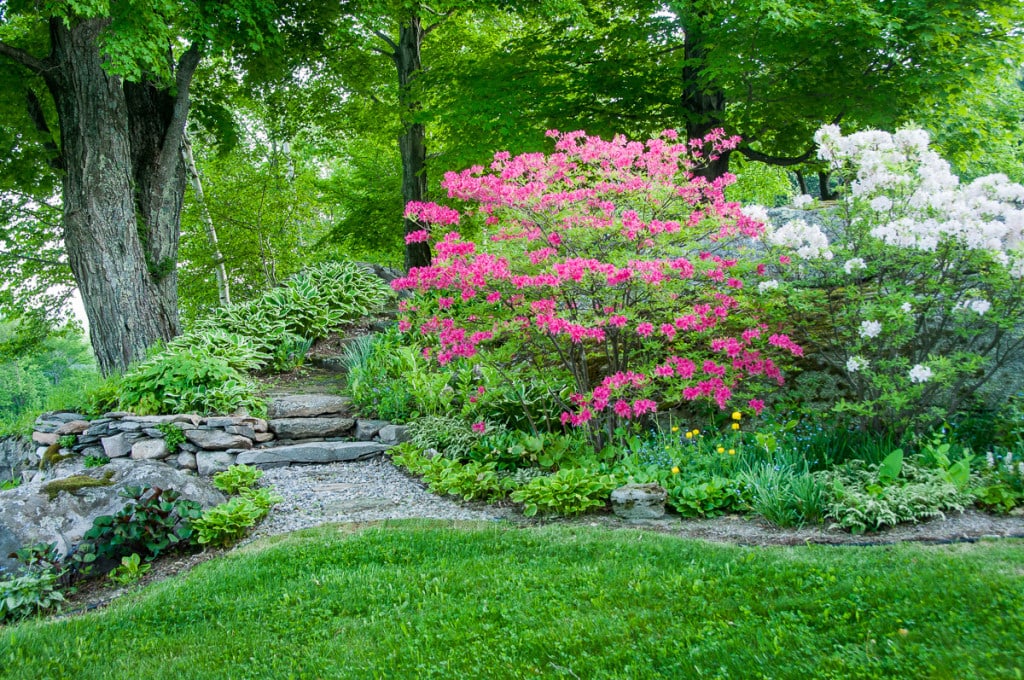
A slight reshaping of the bed outline plus the addition of a stepping stone path greatly improved this small space
Last year I reworked the ground plan in our small front garden, sandwiched between the house, our large rock outcropping and three ancient maple trees by the road.
The change was relatively simple but the results most pleasing: I wanted to smooth the shape of the bed around the big rock outcropping to the steps at the end. I started by removing the indented portion of the lawn that ran up to the steps, replacing it with a short stepping stone path, and then smoothed the final curve to my liking.
Seasonal dynamics
A shade garden has only three seasons, spring flowers, summer tapestries and winter skeletons.
Spring flowers
In the spring, the sun reaches down to the ground through the still leafless trees, and the shady corners of my garden are a riot of early flowers. For me, these early beauties, including bloodroot, scilla, daffodils, twinleaf, virginia bluebells, lungwort, forget-me-nots, woodland phlox, and many more, epitomize the excitement of early spring.
And a bit later the Bleeding heart, Troillus, Blue Poppies and the Lady’s slippers make a brief appearance.
This is a fleeting show so enjoy it while it lasts!
Summer tapestries
After the early flower show is over, my shade gardens completely change their personalities. A few plants have yet to flower, notably Astibles, Aruncus and as well Ligularia, but it is the interplay of leaves which creates the star attraction of summer, and this is the show that lasts and lasts, right up until frost.
While some of the spring flowering plants, known as ephemerals, entirely disappear from view once flowering is complete, others such as bloodroot, epimedium, and twinleaf, continue for the remainder of the growing year. And in late spring these are joined by many others, offering a huge array of size and texture for the artistic gardener to mix-and-match.
Many shade-loving plants are large leaves…all the better to collect the light. Leaves also come in a huge variety of shapes and textures. There are even wonderful color variations to use in your pictures, as not all greens are the same and not all leaves are green!!
Here are some of the leaves you can use to paint beautiful tapestries in the shade:
Not just green: Heuchera, Ligularia dentata,
Lacy textures: Ferns, Astilbe, Aconitum, Aruncus
Arrowheads: Epimedium, Polygonatum,
Broad, crinkled surfaces: Alchemilla mollis, Rodgresia, Darmera and ,yes, many beautiful varieties of Hosta too.
Winter skeletons
The final season is, of course, winter, when the trees and shrubs in our gardens really standout, especially in the snow. If you prune something now, give thought to how it will look in winter; this is when your efforts will show off to best advantage!
Decorations
And last but not least, add a favorite decoration to create an evocative highlight.
As we have seen, for much of the year, the predominate color in the shade garden is green, making it the perfect spot for a special piece of sculpture or pottery—that ironically would be completely lost in the busyness of a sunny perennial border.
I was at a friend’s garden the other day and she had set a beautiful Buddha in a sea of shiny myrtle (Vinca minor). The result was perfect— serene and tranquil.
And see here how one my special pots, handmade by friend Robert Compton, sits up among a cool expanse of Lamium ‘White Nancy’ that grows under my serviceberries—an elegant finishing touch for this favorite corner.
